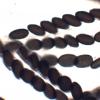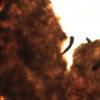
24-12-2025 17:08
Hulda Caroline HolteHello, I have found this propoloid ascomycete on

21-12-2025 09:32
Hello.A tiny ascomycete found embedded in wood in

21-12-2025 21:32
Pol DebaenstHello, Garden, Burgweg 19, Veurne, BelgiumOn 10/1

22-12-2025 23:38
Patrice TANCHAUDBonsoir, récolte sur un mur en pierre, apothéci

22-12-2025 00:47
Patrice TANCHAUDBonsoir, récolte à proximité du milieu dunaire
Thanks
Mal

Good evening Malcolm.
Still a difficult genre where species are delicate to separate. On your picture of the spores one sees nevertheless that the latter are rather wide. One must be wary of the three dimensions and make numerous preparations and measure many spores. Try to see if the germ slit goes around the spore. You can also measure the asci. I do not know C.saccardoi, but Checa gives longer spore measurements.
Your mushroom could be within the size range of C.discospora.
Michel.
Mal

Michel.
Very similar to the first find with spores (10.3)11.21(12.25) x (5.2)5.68(6.5) x (6.44)7.27(7.61) 30 spores measured.
It does not fit perfectly with any in Ellis and Ellis, Keys to Dung Fungi, Dung Fungi of New Zealand or The Genus Conichaeta Checa (thanks Michel). The best fit seems to be C discospora currently synonomised with C ligniarea in the UK.
Thanks for all your help.
Mal

